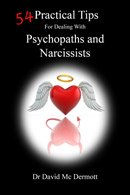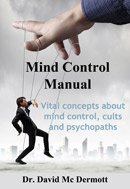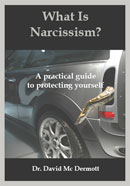Notes On The Robert Hare
Psychopathy Checklist - Revised
The Robert Hare Psychopathy Checklist - Revised is considered by clinicians and researchers worldwide to be the 'gold standard' in assessing psychopathy. It is a complex clinical tool that is only used by experts in the field.
It is also considered to be the most accurate predictor of violent behavior that we have. Therefore, it is also being used to assess the probability of a criminal re-offending as well as determining the length of sentence and whether or not treatment is advised.
Who can use it?
The results of this test have far-reaching implications for the patient, and so its use is confined to a small group of people. These people should have degrees in medical or behavioral science, be certified to diagnose mental disorders (e.g., psychiatrists and psychologists) and be experienced in working with criminal populations. As well as this they need to be trained in the use of the Hare Psychopathy Checklist - Revised.
The results are considered sufficiently important that it is recommended that two clinicians perform the test independently and the results averaged in order to give a more reliable assessment.
Different versions
Originally having 16 items, the Hare Psychopathy Checklist - Revised has 20 and it is divided into two broad categories. The first is about the selfish, unfeeling use of others and assesses interpersonal relationships and affect or mood. The second category is about the antisocial, deviant lifestyle and it assesses the impulsive lifestyle and antisocial behavior.
There is a Screening Version where the 20 items are scaled down to 12. This can be done in about an hour and a half and can be used by people who don't necessarily have the full training in how to use the full checklist. It is used for psychiatric evaluations as well as for personnel selection. It is considered a reliable indicator of psychopathy and it indicates when a full evaluation would be useful.
The Hare P-Scan is used as a rough screen and is used in law enforcement and other areas to detect the possible presence of psychopathy and to manage risk for criminal or violent behavior.
The Hare Psychopathy Checklist - Revised was initially developed when dealing with adult males. But because psychopathy symptoms show up in childhood as well, Robert Hare developed the Hare Psychopathy Checklist: Youth Version.
It also has 20 items and is used by experts to assess the interpersonal, behavioral and affective aspects of psychopathy in 12 to 18-year-olds. Like the full checklist, it uses an interview as well as background information (psychopaths are expert liars) to complete the assessment.
There is also an Antisocial Process Screening Device to detect such things in young populations with the aim of taking preventative measures and averting problems later. The parents fill out a form, as well as the teacher and other relevant people who have sufficient knowledge of the child.
The 20 items
The Hare Psychopathy Checklist - Revised consists of 20 items which are rated 0 to 2, zero meaning 'does not apply', one 'applies somewhat' and two 'applies fully'. The Hare Psychopathy Checklist - Revised is completed on the basis of firstly, an interview with the subject, and secondly, corroborating information such as criminal history, medical history, school history etc.
The 20 items of the Hare Psychopathy Checklist - Revised are
1. GLIB and SUPERFICIAL CHARM - smooth talking, verbally agile, a psychopath is rarely stuck for something to say. They are not in the least bit shy. In fact, they are not afraid to say anything!
2. GRANDIOSE SELF-WORTH - they have an opinion on everything, they boast and brag about the things they have done, their skills and abilities. They have enormous egos, plenty of confidence and arrogance and consider themselves superior. One psychopath said that he preferred to hear himself talk, because what he said was more interesting than what other people had to say.
3. SEEK STIMULATION or PRONE TO BOREDOM - they like to be doing new and different things, always looking for excitement and entertainment. They take risks in what they do as well as what they say. For example, cult leaders, in a subtle way, may explain to their victims how exactly they are manipulating them. They rarely engage in activities that they find boring, or they don't finish the job.
4. PATHOLOGICAL LYING - their ability to lie is stunning, even when they know there is a high probability of being caught. Lies can be cunning and sly or unscrupulously manipulative.
5. CUNNING AND MANIPULATIVENESS - they deceive, cheat, con, bilk, trick or defraud others for personal gain. This is separated from no. 4 to the extent that the subject shows 'callous ruthlessness', that is, a lack of concern or pity for the suffering and feelings of their victims.
6. LACK OF REMORSE OR GUILT - despite their words they experience little emotion or concern for the pain and suffering of their victims. They are unfazed, dispassionate, cold hearted, and unempathetic. There is often a disdain for the victims, and they may even say the victims deserved it.
7. SHALLOW AFFECT - emotional poverty or very shallow feelings, coldness towards others despite seeming very friendly.
8. CALLOUSNESS and LACK OF EMPATHY - a general lack of feelings towards other people. They tend to be heartless, contemptuous, indifferent and tactless.
9. PARASITIC LIFESTYLE - they will intentionally manipulate and exploit others for financial gain. This goes along with poor motivation and little self-discipline and no sense of responsibility in terms of earning their own living.
10. POOR BEHAVIORAL CONTROLS - there may be sudden expressions of annoyance, irritability, aggression and verbal abuse. There may be sudden outbursts of anger and temper and they may act hastily.
11. PROMISCUOUS SEXUAL BEHAVIOR - they may have many brief encounters, many affairs while married, and may be indiscriminate in selecting partners (heterosexual and homosexual relationships) and even maintain several relationships at the same time. There is often a history of attempting to coerce many people into sexual relationships and they may take great pride in discussing their sexual conquests.
12. EARLY BEHAVIOR PROBLEMS - there is often a history of antisocial behavior before age 13, including lying, stealing, cheating, vandalism, bullying, truancy, sexual activity, fire-setting, substance abuse, and running away from home. Cruelty to animals or siblings is particularly ominous.
13. LACK OF REALISTIC, LONG-TERM GOALS - while they talk about big plans, they show an inability or persistent failure to execute long-term goals; then may drift from one place to another lacking any real direction in life.
14. IMPULSIVITY - many of their behaviors are not premeditated and seem to be unplanned. They seem unable to resist temptation and urges or to delay gratification. They may not consider the consequences and so they appear reckless, foolhardy and unpredictable.
15. IRRESPONSIBILITY - they will repeatedly fail to honor commitments or obligations, in school, work, family or social situations. The fail to turn up, don't pay bills, fail to honor contracts etc.
16. FAILURE TO ACCEPT RESPONSIBILITY FOR OWN ACTIONS - it seems like it's never their fault or their responsibility. They have little or no sense of duty or conscientiousness and often deny their responsibility. And in denying, they will even try and manipulate others!
17. MANY SHORT-TERM MARITAL RELATIONSHIPS - inability to maintain a long-term relationship because they are inconsistent and unreliable.
18. JUVENILE DELINQUENCY - behavioral difficulties between the ages of 13-18. Typically behaviors that are crimes or are clearly manipulative, aggressive and callous.
19. REVOCATION OF CONDITION RELEASE - they may have had their probation revoked for technical reasons such as failing to appear, carelessness and so on.
20. CRIMINAL VERSATILITY - unlike other criminals who may specialize in one area they are often involved in diverse activities, taking great pride at getting away with crimes.
Results
On the Hare Psychopathy Checklist - Revised subjects score between 0 and 40, zero being no psychopathy symptoms and 40 being a full-blown psychopath.
Normal individuals typically score less than five and many non-psychopathic criminals (who do actually have symptoms of antisocial personality disorder) may score 20 to 22.
A score over 30 on the Hare Psychopathy Checklist - Revised is used to diagnose the presence of psychopathy.
Read more about the characteristics of a psychopath and how they use mind control to manipulate. More information here on how to recognize a psychopath, abusive relationships and how to recover from a psychopathic relationship.
Like this page?
Consultations
Would you like to talk to someone about your situation?
If you think you are or have been in a cult or a destructive relationship, or a friend or family member might be in a cult and you want to talk to someone, send me a message on the Contact page and we can arrange to talk. All communication will be treated in the strictest confidence.
Available now!

54 Practical Tips For Dealing With Psychopaths and Narcissists
You have the theory but how do you actually apply it? This book spells it out...
Mind Control Manual

Vital concepts about mind control, cults
and psychopaths
Do you think that you might be in an abusive relationship? Are you realizing that the group you are in may be a cult?
What Is Narcissism?

A practical guide to protecting yourself
Do you think you are being taken advantage of emotionally, physically, sexually or financially in your relationship? Do you want to leave but you can't seem to get away?
Tips for dealing with psychopaths and narcissists
Fortnightly newsletter with practical tips and ideasLearn more...
Plus!
'7 Vital Do's and Don'ts of Decision Making' when you subscribe!